A Multipurpose and Efficient Evaluation Method of Phase Characteristics in a Quiet Zone for a Defocused Feed in a Compact Antenna Test Range
Abstract
1. Introduction
2. Precise Formula Derivation of Phase Characteristics in a Quiet Zone for a Defocused Feed
2.1. Single Paraboloid
2.2. Dual Parabolic Cylinders
3. Application of the Evaluation Method Based on Precise Formulas
- For a single paraboloid, the focal length is F = 8.483 m, the central coordinate of the quiet zone is (xm, ym, zm) = (0 m, 3.35 m, 11.85 m), the size of the quiet zone is 2.5 m, the horizontal range on the central section of the quiet zone is [−1.25 m, 1.25 m], and the vertical range on the central section of the quiet zone is [2.1 m, 4.6 m] [12], as shown in Figure 1;
- For dual parabolic cylinders, the focal lengths of the sub reflector and main reflector are F1 = 5.915 m and F2 = 7.02 m, respectively. The deflection angle of the main reflector is θ0 = 65°, the deflection angle of the sub reflector is θ2 = 96.5°, the offset angle of the feed is θ1 = 18.5°, the arc length of the main reflector is AB = 5.34 m, the width of the sub reflector is CD = 3.745 m, the central coordinate of the quiet zone is (xm, ym, zm) = (9.23 m, 8.945 m, 0 m), the size of the quiet zone is 2 m, the horizontal range on the central section of the quiet zone is [7.945 m, 9.945 m], and the vertical range on the central section of the quiet zone is [−1 m, 1 m], as shown in Figure 2;
- The relationship between the phase response of the quiet zone and the distance of ray propagation can be expressed as [9]
- 4.
- Given that coordinates in the Cartesian coordinate system consist of three components: x, y, and z, the feed defocusing value can also be decomposed into three components correspondingly. Any defocusing case can be synthesized from the three individual component cases above linearly, and the vector expression for any defocusing case can be written aswhere DFx, DFy, and DFz represent the x, y, and z components of the feed defocusing value, respectively, while , , and represent the unit vector in the x, y, and z directions of the Cartesian coordinate system, individually;
- 5.
- All software simulations are conducted using the commercial software FEKO 2021.2, while all formula calculations are performed using the optimization software 1stOpt 9.0.
3.1. Prediction of Machining Accuracy Tolerances for Feeds and Their Turntable
3.1.1. Single Paraboloid
- When calculating the horizontal line on the central section, x = [xm − 1.25 m, xm + 1.25 m], y = ym, z = zm;
- When calculating the vertical line on the central section, x = xm, y = [ym − 1.25 m, ym + 1.25 m], z = zm;
- When calculating the central section, x = [xm − 1.25 m, xm + 1.25 m], y = [ym − 1.25 m, ym + 1.25 m], z = zm.
- When defocusing in the single x direction, DFx = x0 = , DFy = y0 = 0 m, DFz = z0 − F = 0 m;
- When defocusing in the single y direction, DFx = x0 = 0 m, DFy = y0 = , DFz = z0 − F = 0 m;
- When defocusing in the single z direction, DFx = x0 = 0 m, DFy = y0 = 0 m, DFz = z0 − F = .
3.1.2. Dual Parabolic Cylinders
- When calculating the horizontal line on the central section, x = xm, y = [ym − 1 m, ym + 1 m], z = zm;
- When calculating the vertical line on the central section, x = xm, y = ym, z = [zm − 1 m, zm + 1 m];
- When calculating the central section, x = xm, y = [ym − 1 m, ym + 1 m], z = [zm − 1 m, zm + 1 m].
- When defocusing in the single x direction, DFx = x0 − xf = , DFy = y0 − yf = 0 m, DFz = z0 − zf = 0 m;
- When defocusing in the single y direction, DFx = x0 − xf = 0 m, DFy = y0 − yf = , DFz = z0 − zf = 0 m;
- When defocusing in the single z direction, DFx = x0 − xf = 0 m, DFy = y0 − yf = 0 m, DFz = z0 − zf = .
3.2. Guidance of On-Site Installation for Feeds and Their Turntable
3.3. Confirmation of Feed Position for Equivalent Pitch Tests of the Target Under Measurement
- The coordinates of two endpoints on the vertical line need to be determined based on the size of the quiet zone and pitch angle;
- The phase of all points is referenced to the center point, and are all equal to each other, which means the difference is 0;
- The calculation result is independent of the operating frequency.
3.4. Others
- Theoretical foundation of multi-feed distribution. In recent years, numerous scholars have adopted a turntable layout for multi-feed distribution to enhance the efficiency of RCS testing in a compact range without a clear theoretical basis [13,14,15,16,17]. As is evident from Section 3.1, so long as multiple sets of transmitting and receiving feeds within the same frequency band are odd-symmetrically distributed on the installation surface with the focus as the origin, phase compensation of the transmitting and receiving paths can be achieved. A reduction in the feed disassembly frequency and improvement of the testing efficiency can be realized in this way.
- Identification of key processing areas for the reflector. In practical application of the aforementioned cases, the calculation results of reflection points on the reflector are available; meanwhile, the reflection points’ area depends on the range of quiet zone. Considering the direct correlation between the high-frequency performance of the reflector and its surface accuracy, coupled with its pronounced local effects, it is imperative to prioritize the processing of the reflection points’ area during precision machining.
- Error elimination of the scanning frame system for the quiet zone test. As is evident from Figure 12a,c and Figure 13a,c, the phase error along any straight path within the sampling plane exhibits linearity during the quiet zone test [9]. Assuming the phase center of the feed coincides with the focus, the least squares method can be employed to perform a first-order fit on the measured phase data of horizontal or vertical lines, to yield the phase difference between the two endpoints of the fitted line. Subsequently, by substituting this value into Equation (5), the overall offset distance of the scanning frame system along the z-axis or x-axis, corresponding, respectively, to single paraboloid and dual parabolic cylinders, can be calculated to eliminate the errors caused by machining or installation.
4. Conclusions
Author Contributions
Funding
Data Availability Statement
Conflicts of Interest
Abbreviations
| CATR | Compact Antenna Test Range |
| GO | Geometric Optics |
Appendix A
References
- Johnson, R.C.; Ecker, H.A.; Moore, R.A. Compact Range Techniques and Measurements. IEEE Trans. Antenna Propag. 1969, 17, 569–576. [Google Scholar] [CrossRef]
- CTIA Certification Program, V1.0; Test Plan for Millimeter-Wave Wireless Device Over-the-Air Performance; CTIA Certification: Washington, DC, USA, 2020.
- 3GPP TR 38.810, NR; Study on Test Methods; 3GPP Organization: Sophia Antipolis, France, 2019.
- Jabbar, A.; Kazim, J.U.; Shawky, M.A.; Imran, M.A.; Abbasi, Q.; Usman, M.; Ur-Rehman, M. High Performance 5G FR-2 Millimeter-Wave Antenna Array for Point-to-Point and Point-to-Multipoint Operation: Design and OTA Measurements Using a Compact Antenna Test Range. Prog. Electromagn. Res. M 2025, 132, 73–84. [Google Scholar] [CrossRef]
- Park, S.H.; Kim, Y.N.; Kim, H.N.; Moon, T.S.; Park, J.H. Active Performance Verification of 28 GHz 5G Beam-forimg Antenna Module using CATR Chamber. In Proceedings of the 2024 International Symposium on Antennas and Propagation (ISAP), Incheon, Republic of Korea, 5–8 November 2024. [Google Scholar]
- Zhou, Y.H. Advancing 5G Calibration Methods In The Compact Antenna Test Range. Bachelor’s Thesis, Lund University, Lund, Sweden, 2024. [Google Scholar]
- Zhu, Y.; Yang, S.Y.; Zhang, Y.; Ma, Y.C. Measurement Uncertainty Assessment for a 5G Millimeter Wave OTA Test System. In Proceedings of the 2023 International Conference on Microwave and Millimeter Wave Technology (ICMMT), Qingdao, China, 14–17 May 2023. [Google Scholar]
- Zhang, Y.; Wu, X.; Zhang, X.; Ren, Y.X.; Pan, C.; Wei, G.M. Test Methodology and System for 5G Millimeter Wave Terminal RF Conformance. Wirel. Technol. Intell. Netw. Technol. Smart Serv. Appl. 2022, 11, 87–92. [Google Scholar]
- Qu, M.J.; Liu, G.H.; Wang, P.H.; Sun, S.Y. Removing Phase Misalignment in the Validation of a Compact Antenna Test Range for 5G mm-Wave UE OTA Testing. IEEE Trans. Electromagn. Compat. 2021, 63, 1295–1299. [Google Scholar] [CrossRef]
- Baggett, M.C.; Swarner, W.G. Use of Clustered Feeds in a Compact Range for RCS Measurements. In Proceedings of the 1990 Antenna Measurement Techniques Association Symposium (AMTA), Atlanta, GA, USA, 2–5 November 1990. [Google Scholar]
- Fordham, J.A.; Park, T. Compact Range Phase Taper Effects Due to Phase Center Shift in WideBand Quad-Ridge Feeds. In Proceedings of the 2002 Antenna Measurement Techniques Association Symposium (AMTA), San Diego, CA, USA, 6–11 October 2002. [Google Scholar]
- Jiang, Y.Q.; Mo, C.J.; Chen, W.Q.; Kong, D.W. Research on Serrations of Reflector Used in CATR. In Proceedings of the 2019 Photonics & Electromagnetics Research Symposium(PIERS), Xiamen, China, 17–20 December 2019. [Google Scholar]
- Gong, Y.J.; Li, D.S.; Wang, M.M.; Liu, Z.M. Robot-based Precise Offset-Focus Feed Control System Used in the Compact Antenna Test Range. In Proceedings of the 2018 IEEE Asia-Pacific Conference on Antennas and Propagation (APCAP), Auckland, New Zealand, 5–8 August 2018. [Google Scholar]
- Ning, Z.H.; Wang, Z.P.; Yu, Z.Y. Design of A Millimeter wave Multi-Feeds Compact Range. In Proceedings of the 2020 IEEE MTT-S International Wireless Symposium (IWS), Shanghai, China, 20–23 September 2020. [Google Scholar]
- Pan, C.; Ning, Z.H.; Wang, Z.P.; Wang, X. A Multi-feed Compact Antenna Test Range for 5G Millimeter Wave OTA Test. In Proceedings of the 2021 International Conference on Microwave and Millimeter Wave Technology (ICMMT), Nanjing, China, 23–26 May 2021. [Google Scholar]
- Pan, C.; Song, M.S.; Yang, X.H.; Wang, Z.P.; Ning, Z.H. Design and Application of Off-focus Multi-feed Compact Range for 5G Over-the-Air Test. In Proceedings of the 2022 International Applied Computational Electromagnetics Society Symposium (ACES-China), Xuzhou, China, 9–12 December 2022. [Google Scholar]
- Rocco, C.; Patrizia, L. A Novel Shape of Bowtie Antenna Arranged in a Linear Array for Energy Harvesting in MID-IR Band. In Proceedings of the 2023 12th International Conference on Renewable Energy Research and Applications (ICRERA), Oshawa, ON, Canada, 29 August–1 September 2023. [Google Scholar]

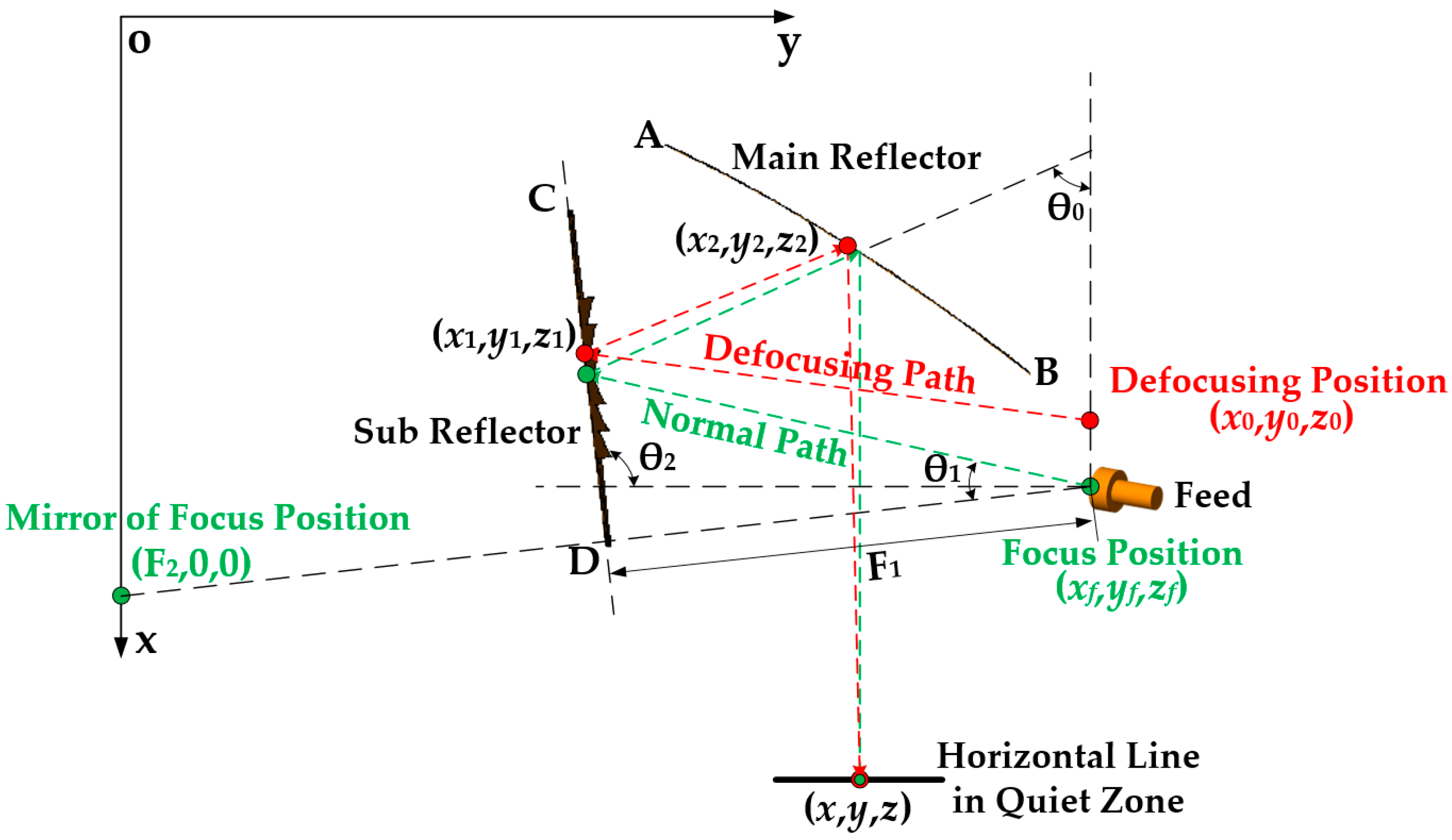



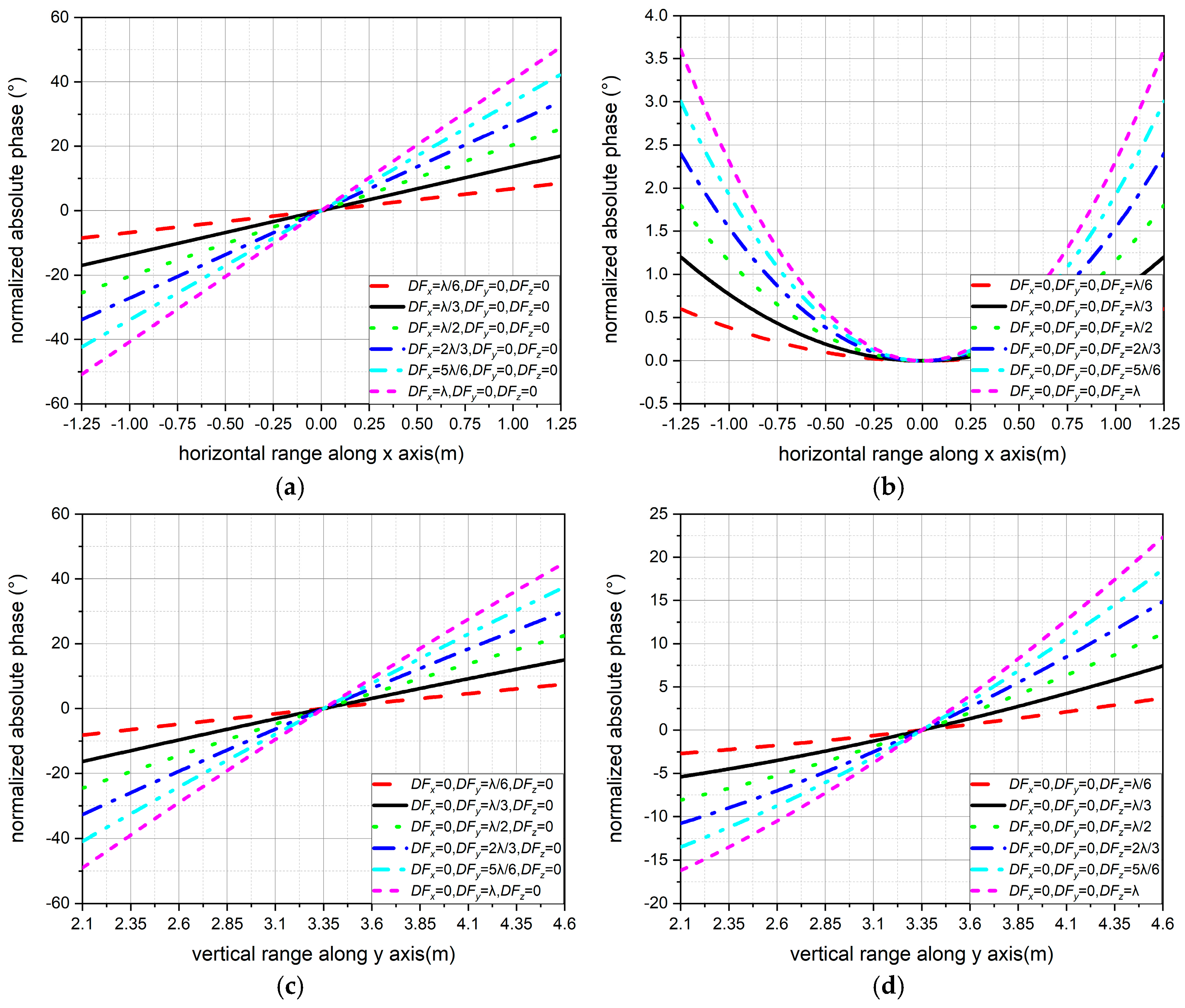



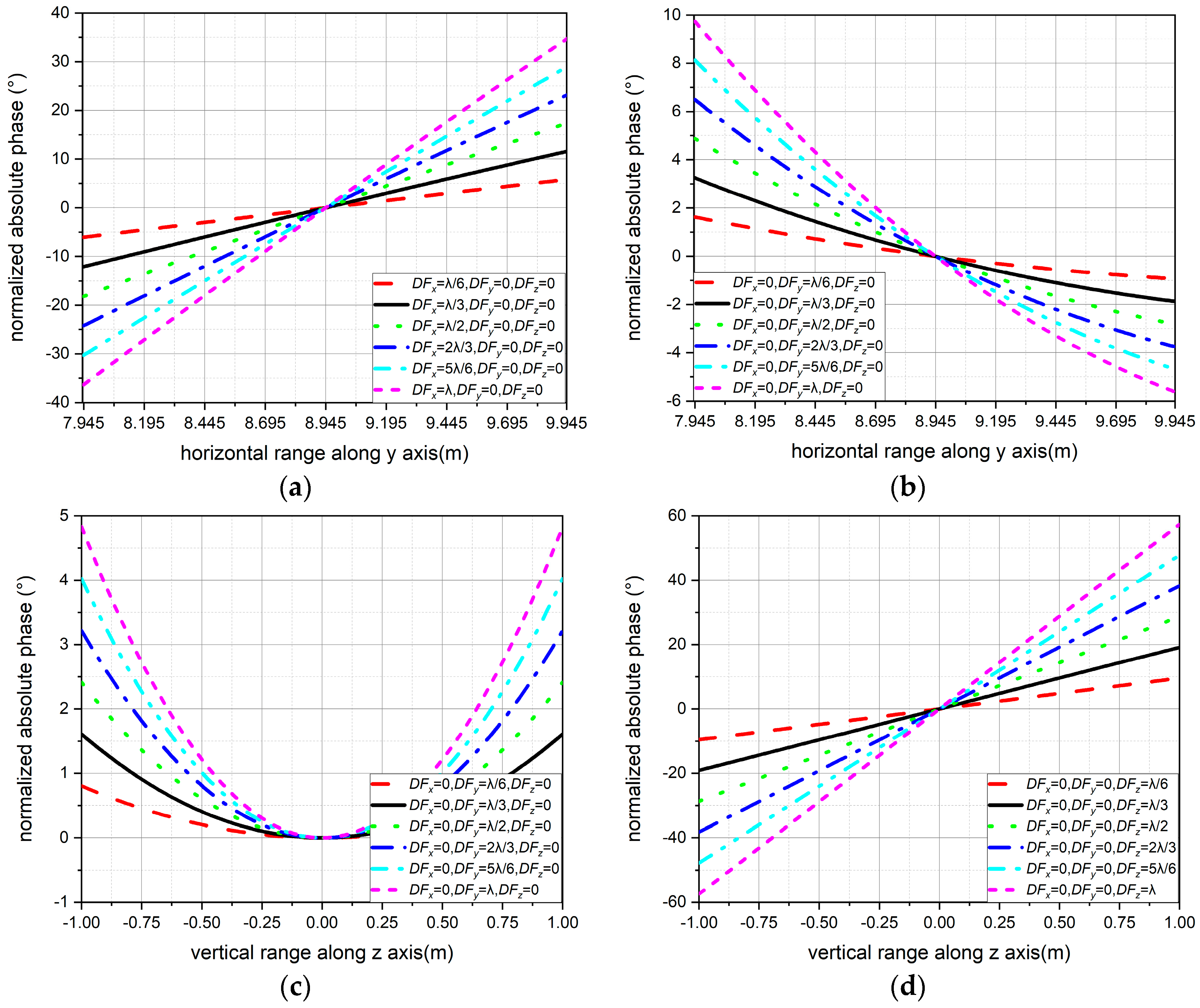

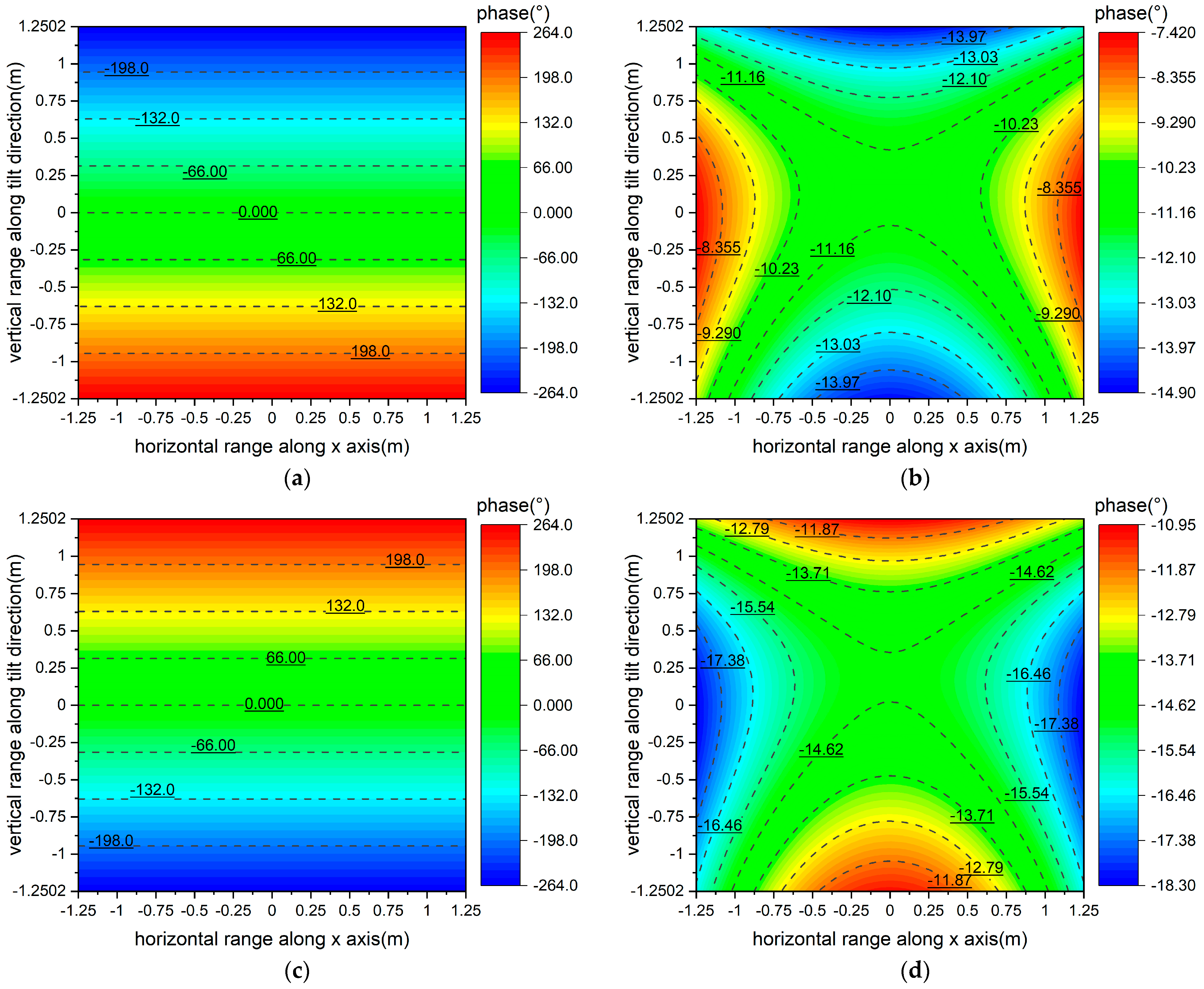
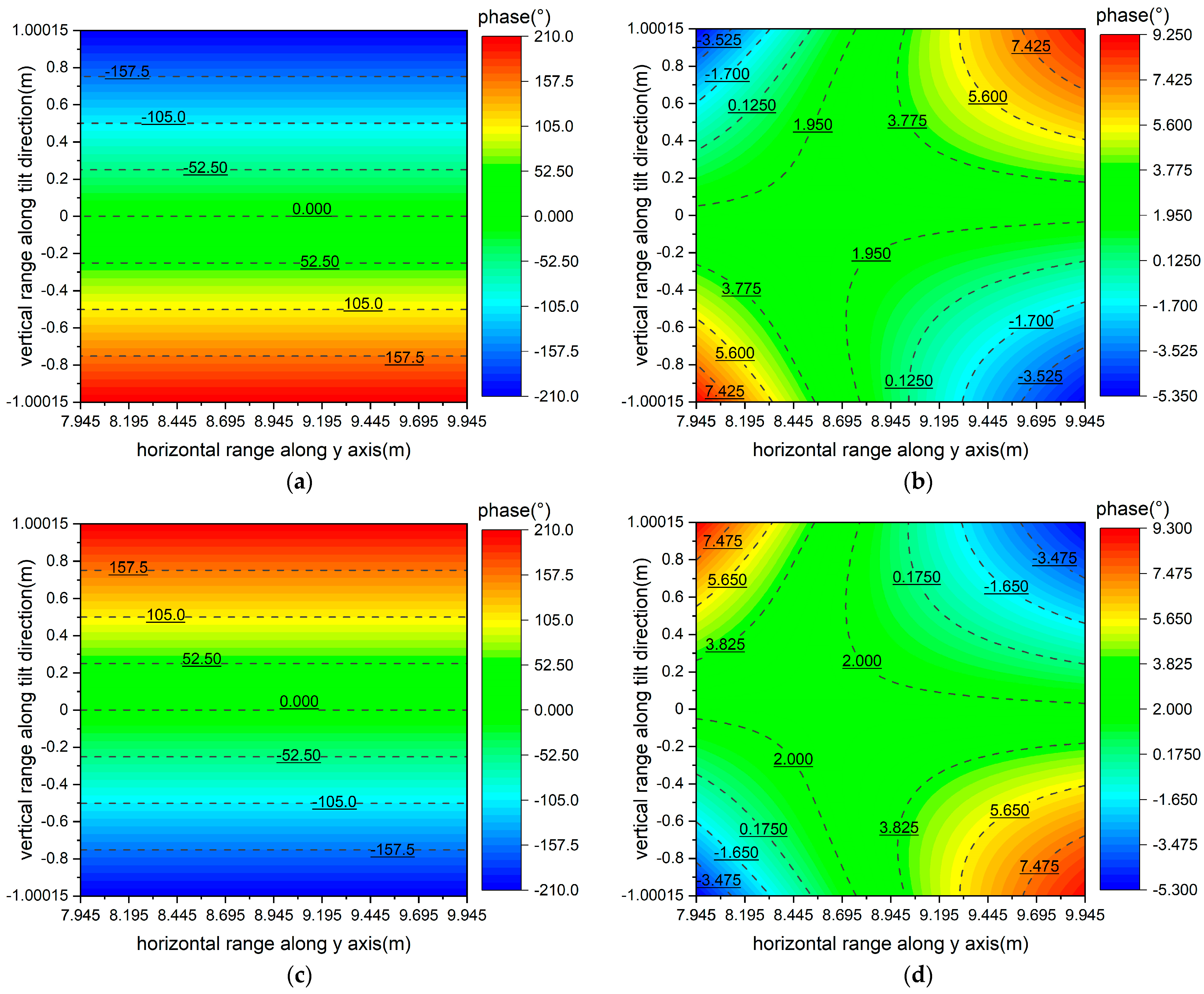
| NO. 1 | NO. 2 | NO. 3 | NO. 4 | NO. 5 | NO. 6 | NO. 7 | NO. 8 | NO. 9 | NO. 10 | |
|---|---|---|---|---|---|---|---|---|---|---|
| x0 | 0.0100 | 0.0100 | 0.0100 | 0.0100 | 0.0100 | 0.0100 | 0.0100 | 0.0100 | 0.0100 | 0.0100 |
| y0 | −0.0001 | −0.0002 | −0.0002 | −0.0001 | −0.0007 | −0.0008 | 0.0001 | −0.0006 | −0.0001 | −0.0003 |
| z0 | 8.4833 | 8.4837 | 8.4838 | 8.4836 | 8.4838 | 8.4835 | 8.4838 | 8.4834 | 8.4838 | 8.4832 |
| NO. 1 | NO. 2 | NO. 3 | NO. 4 | NO. 5 | NO. 6 | NO. 7 | NO. 8 | NO. 9 | NO. 10 | |
|---|---|---|---|---|---|---|---|---|---|---|
| x0 | 5.6812 | 5.6804 | 5.6799 | 5.6803 | 5.6800 | 5.6815 | 5.6803 | 5.6806 | 5.6815 | 5.6817 |
| y0 | 11.7535 | 11.7542 | 11.7532 | 11.7541 | 11.7548 | 11.7537 | 11.7543 | 11.7535 | 11.7544 | 11.7546 |
| z0 | 0.0002 | 0.0004 | −0.0002 | 0.0008 | −0.0004 | 0.0005 | −0.0005 | −0.0001 | 0.0002 | −0.0003 |
Disclaimer/Publisher’s Note: The statements, opinions and data contained in all publications are solely those of the individual author(s) and contributor(s) and not of MDPI and/or the editor(s). MDPI and/or the editor(s) disclaim responsibility for any injury to people or property resulting from any ideas, methods, instructions or products referred to in the content. |
© 2025 by the authors. Licensee MDPI, Basel, Switzerland. This article is an open access article distributed under the terms and conditions of the Creative Commons Attribution (CC BY) license (https://creativecommons.org/licenses/by/4.0/).
Share and Cite
Jiang, Y.; Qu, M.; Yin, H.; Mo, C.; Liu, Z. A Multipurpose and Efficient Evaluation Method of Phase Characteristics in a Quiet Zone for a Defocused Feed in a Compact Antenna Test Range. Electronics 2025, 14, 4389. https://doi.org/10.3390/electronics14224389
Jiang Y, Qu M, Yin H, Mo C, Liu Z. A Multipurpose and Efficient Evaluation Method of Phase Characteristics in a Quiet Zone for a Defocused Feed in a Compact Antenna Test Range. Electronics. 2025; 14(22):4389. https://doi.org/10.3390/electronics14224389
Chicago/Turabian StyleJiang, Yongquan, Meijun Qu, Hongcheng Yin, Chongjiang Mo, and Ziwei Liu. 2025. "A Multipurpose and Efficient Evaluation Method of Phase Characteristics in a Quiet Zone for a Defocused Feed in a Compact Antenna Test Range" Electronics 14, no. 22: 4389. https://doi.org/10.3390/electronics14224389
APA StyleJiang, Y., Qu, M., Yin, H., Mo, C., & Liu, Z. (2025). A Multipurpose and Efficient Evaluation Method of Phase Characteristics in a Quiet Zone for a Defocused Feed in a Compact Antenna Test Range. Electronics, 14(22), 4389. https://doi.org/10.3390/electronics14224389







